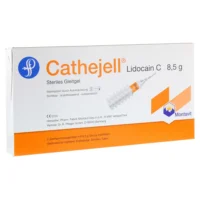Description
Alfort Dexa (Dexketoprofen Trometamol) Solution for Injections 50 mg/2 ml Ampoules 2 ml №5
Ingredients:
Each 2 ml ampoule contains 50 mg of dexketoprofen trometamol.
Mechanism of Action:
Alfort Dexa acts by inhibiting the enzyme cyclooxygenase, leading to a reduction in prostaglandin synthesis, which is crucial in the inflammatory cascade. This mechanism results in analgesic, anti-inflammatory, and antipyretic effects.
Pharmacological Properties:
Dexketoprofen trometamol, the active component of Alfort Dexa, belongs to the class of nonsteroidal anti-inflammatory drugs (NSAIDs). It exhibits potent analgesic properties and anti-inflammatory actions by interfering with prostaglandin synthesis.
Indications for Use:
Alfort Dexa is indicated for the management of moderate to severe pain, particularly in scenarios where oral administration is impractical. It is commonly employed in postoperative settings and conditions necessitating potent analgesia.
Contraindications:
Avoid administering Alfort Dexa to individuals with a known history of hypersensitivity to dexketoprofen or other NSAIDs. Furthermore, it is contraindicated in patients with active peptic ulcers, gastrointestinal bleeding, or a history of asthma induced by NSAIDs.
Side Effects:
Common side effects of Alfort Dexa may include gastrointestinal disturbances such as dyspepsia, nausea, and gastritis. Additionally, renal impairment, hypersensitivity reactions, and skin rashes have been reported. Monitoring for adverse effects is essential during therapy.
Usage Instructions:
The standard dosage of Alfort Dexa is 50 mg (1 ampoule) administered via deep intramuscular injection once daily. It is crucial to adhere to the prescribed dosage and treatment duration. Caution is advised when using Alfort Dexa in the elderly population and in patients with renal or hepatic insufficiency.
Benefits Compared to Analogues:
Alfort Dexa offers a rapid onset of action and superior analgesic efficacy compared to some traditional NSAIDs. Its favorable tolerability profile and reduced risk of gastrointestinal adverse effects make it a preferred choice in pain management regimens.
Suitable Patient Groups:
Alfort Dexa can be safely used in adults, including the elderly population, for the management of acute pain conditions. However, caution should be exercised in patients with compromised renal or hepatic function.
Storage Conditions and Shelf Life:
Store Alfort Dexa in a cool, dry place away from direct sunlight. Ensure proper sealing of the ampoules to prevent contamination. Check the expiration date before use and discard any expired product appropriately.
Packaging Description:
Alfort Dexa is available in ampoules containing 2 ml of solution for injections, with each ampoule delivering 50 mg of dexketoprofen trometamol. The packaging includes 5 ampoules per pack for clinical use.
Clinical Evidence and Proven Effectiveness:
Studies have demonstrated the efficacy of dexketoprofen trometamol in managing various pain conditions. Research by Lanas et al. (2004) highlighted the superior analgesic efficacy of dexketoprofen compared to placebo in postoperative pain relief.





